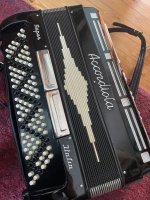Hello all, I've just bought a 2nd-hand Accordiola Super Italia for a super-low price, just to give it a go (I've played piano accordion for a few years but always wanted to try button).
Can anyone tell me about this make / model? I've looked online but only found models for sale, no information about it. It has an On-Off slider above the keyboard which I can't work out if it makes a difference to the tone or not. Any information appreciated

Can anyone tell me about this make / model? I've looked online but only found models for sale, no information about it. It has an On-Off slider above the keyboard which I can't work out if it makes a difference to the tone or not. Any information appreciated


